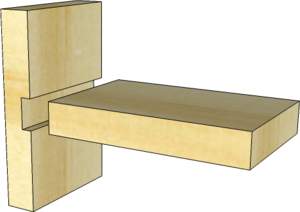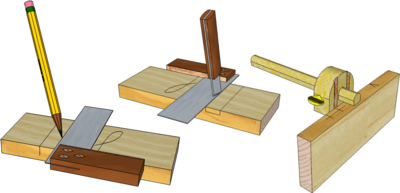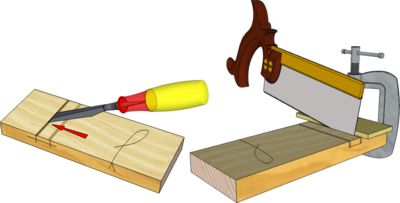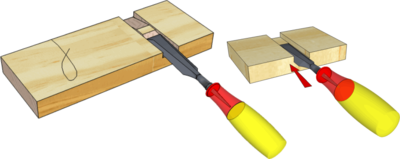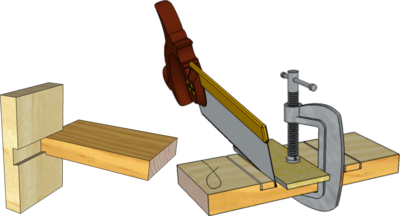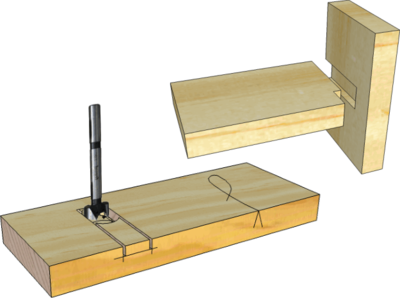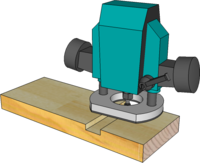Housing Joint
From DT Online
Description
A Housing Joint is used for fixing shelves and partitions into cabinets and book-cases for example. The Housing (aka Trench or Dado) is cut across the Grain to a width normally equal to the thickness of the shelf or partition it is to receive. (Note: finest quality cabinet work may include housings which are less than the shelf thickness such that shoulders are created).
Marking Out
- Prepare the timber to size and mark Face Side and Face Edges.
- Mark the Housing across the face of board using a pencil and a Try Square held against the Face Edge and mark half way down each edge holding the Try Square against the Face Side.
- Use a Marking Knife and a Try Square held against the Face Edge to scribe along the edges of the Housing.
- Use a Marking Gauge held against the Face Side to scribe the depth of the Housing (Note: depth can vary with the task in hand but should not be more than one third of the timber thickness)
Sawing the Housing
- Use a Chisel to Pare away waste and cut a 'Vee' groove to guide the saw.
- 'G' Cramp the board to the bench top and, if needed (e.g. especially on wide boards) clamp a length of timber along the edge of the Housing to rub the saw against and guide it.
- Also if needed, a piece of suitable thickness timber can be clamped to the bench at the rear of the Housing to serve as a 'depth stop' when sawing.
- Use a Tenon Saw carefully to cut along the edges of the Housing.
Cutting the Housing
- 'G' Cramp the board to the bench top and, using a Chisel and Mallet remove waste from one half only (to avoid the timber splitting out at the rear of the joint).
- Turn the timber around and complete waste removal from the Housing.
- Holding a Chisel with one hand on the handle and one on the blade, Pare away any remaining waste and finish to the lines.
Note: When Paring with a Chisel it improves control if the knuckles or rear of the hand gripping the blade are also pressed against the work-piece.
Dovetail Housing Joint
The Housing can be cut with one or both edges angled inwards - as with a Dovetail Joint. This is especially useful on larger bookcases for example, where there might be significant sidewards forces tending to pull the shelf out of the Housing.
- The timber is prepared and joint marked out as usual.
- 'G' Cramp the board to the bench top and, if needed (e.g. especially on wide boards) clamp a length of timber, with its edge planed to the Dovetail angle, along the edge of the Housing to rub the saw against and guide it.
- Mark and scribe the shoulders on the shelf and cut with a Tenon Saw.
- Using a Chisel with one hand on the handle and one on the blade, Pare away the waste to create the Dovetails on the shelf ends.
Stopped Housing Joint
For reasons of aesthetics, it is often preferred if the Housing does not show at the front edges of a cabinet for example.
- Prepare the timber and mark out the joint as usual.
- Start by clearing away waste at the end of the Housing (e.g. using Forstener Bits or similar) to make space for the end of the Tenon Saw when cutting the joint.
- Mark, scribe and cut out a notch at the end of the shelf using Tenon Saw and Chisels.
Using a Router
It is now common practice to cut Housing Joints using a Router.
- The timber is prepared and joint marked out as usual.
- 'G' Cramp the board to the bench top and either, clamp a scrap timber fence across the board at a suitable distance from the Housing location, or clamp on a Router Template to guide the cutter.
- Dovetail Housings are similarly cut using a Dovetail shaped Router Cutter
Safety Point! Students may only use a Router when they have been trained and assessed and the assessment shows that they are competent, and are under appropriate supervision by specifically trained staff.
- Good tools will last a lifetime - buy the best you can afford!
